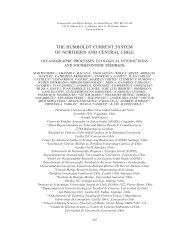Nest-Building Behavior by the Amphipod Peramphithoe ... - Bedim
Nest-Building Behavior by the Amphipod Peramphithoe ... - Bedim
Nest-Building Behavior by the Amphipod Peramphithoe ... - Bedim
Create successful ePaper yourself
Turn your PDF publications into a flip-book with our unique Google optimized e-Paper software.
NEST-BUILDING IN AMPHIPODS<br />
251<br />
Figure 1. Tubiculous nests of <strong>Peramphithoe</strong> femorata on Macrocystis pyrifera blades. (A) Weblike<br />
amphipod-silk produced <strong>by</strong> pereopod glands. (B) <strong>Amphipod</strong> female accompanied <strong>by</strong> its juvenile offspring.<br />
culate <strong>the</strong> mean values. Prior to <strong>the</strong> analysis we checked for<br />
parametric assumptions of normality and homoscedasticity.<br />
To examine whe<strong>the</strong>r nest advancement rates depended on<br />
<strong>the</strong> total duration of occupancy, we used univariate analysis<br />
of variance (ANOVA) to compare <strong>the</strong> advancement of nests<br />
occupied at 2-day intervals, with nest occupancy as fixed<br />
factor. Since few nests were occupied for more than 8 days,<br />
we pooled <strong>the</strong> data for nests that were continuously occupied<br />
for 8, 10, and 12 days. The F statistic for unbalanced<br />
data with missing cells was obtained using Type IV sums of<br />
squares (Landau and Everitt, 2004). Prior to <strong>the</strong> analysis of<br />
variance we checked for normality and homoscedasticity<br />
using Shapiro-Wilks and Levene tests, respectively. When<br />
<strong>the</strong> results from Shapiro-Wilks test were close to <strong>the</strong> critical<br />
value (i.e., 0.05), we examined deviations from normality<br />
using graphical evaluation of data and residuals. As no<br />
severe deviation from normality was found in our data,<br />
parametric ANOVA was conducted.<br />
Results<br />
<strong>Nest</strong>-building and feeding behavior<br />
<strong>Amphipod</strong>s quickly started to build a nest on <strong>the</strong> natural<br />
blades when introduced to <strong>the</strong> aquaria, and after a relatively<br />
short time (about 2 h) <strong>the</strong>y had stabilized <strong>the</strong>ir domiciles<br />
with abundant silk (Fig. 1A, B). The silk threads were<br />
produced in glands on <strong>the</strong> third and fourth pairs of pereopods<br />
(Fig. 2A). Normally, <strong>the</strong> amphipods initiated nest<br />
construction <strong>by</strong> producing an amorphous mass of silk on <strong>the</strong><br />
blade surface. This mass of silk served as anchorage for<br />
pereopods 5, 6, and 7 during <strong>the</strong> initial phase of nest<br />
construction. These posterior pereopods are typically oriented<br />
backward, which allows <strong>the</strong> animals to hold onto<br />
<strong>the</strong> blade firmly while producing new silk threads with<br />
pereopods 3 and 4. At <strong>the</strong> same time, <strong>the</strong> amphipods utilized<br />
<strong>the</strong>ir first and second pairs of pereopods (gnathopods) to










